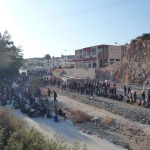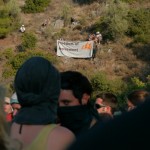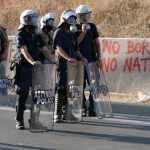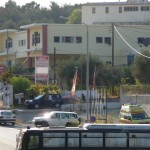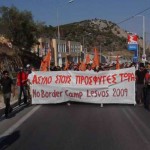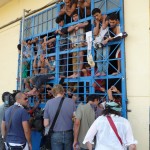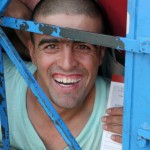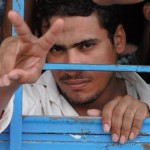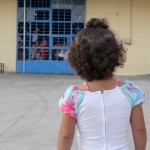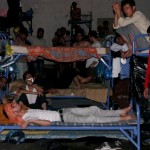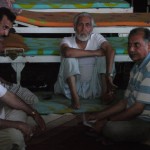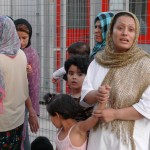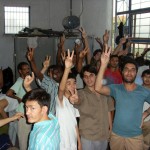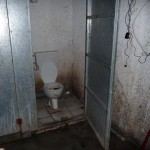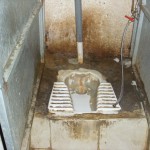 28 of August, or Day 4 of the noborder lesvos 09 was the action day focussing on Pagani detention centre. If you have been following us over the last days, you are familiar with what is going on there. The noborder camp was mobilising for a big demonstration to Pagani, to again demand the immediate release of all prisoners, the closure of Pagani detention centre and the abolition of detention altogether.
28 of August, or Day 4 of the noborder lesvos 09 was the action day focussing on Pagani detention centre. If you have been following us over the last days, you are familiar with what is going on there. The noborder camp was mobilising for a big demonstration to Pagani, to again demand the immediate release of all prisoners, the closure of Pagani detention centre and the abolition of detention altogether.
This points to an important debate as to what the actions taken by the noborder camp aim to achieve. Of course, the immediate release of all prisoners from Pagani is the most urgent demand. However, in merely concentrating on the conditions of Pagani, another point might be missed: the general problem is detention itself, not the conditions of detention in Greece. For clearly, nobody should be detained and thus punished for the mere fact that s~he is migrating. But this is what is happening not only in Greece, but at many places in the extended European border and actually worldwide.
Politically, one should be aware that this ambivalence constitutes a trap that needs to be avoided. In merely calling for the closure of Pagani, one might actually help the border regime to modernize: pressure focussing on Pagani detention centre, following a human rights inspired discourse, could help to free funds for the construction of new detention centres matching international norms. That this is not a theoretical discussion is well illustrated by the dynamics of yesterday:
The UNHCR in Geneva released a report about Pagani, apparently calling for the closure of the facility. However, the harshest statement they issued reads:
The UNHCR staff described the condition of the centre as unacceptable.
Some stronger language could definitely have been found considering the conditions in Pagani. However, the press release of the UNHCR adds to the ambivalence by stating:
UNHCR is participating in an EU funded project that aims to improve reception facilities on the islands of Samos, Chios and Lesvos and at the Evros land border.
Now we all know what these so called reception facilities are: they are mostly jails like Pagani, or modernized versions of it like in Samos. So there we are, right in the middle of the debate: detention or no detention?
You can read this debate also in the politics of noborder Lesvos. The camp played a large part in creating the dynamics that led to the international scandalisation of Pagani detention centre. Especially our first video Voices from the Inside of Pagani, which to date has been watched more than 5.000 times and which we started pushing over international distribution networks, has caused a stirr and might well lead to the closure of Pagani in the end. However, we also started pushing for an alternative policy towards detention. It was also our pressure that lead to the opening of an open reception facility and the issuing of papers for 22 migrants without them being detained. Considering the temporary character of the new facility and the large numbers of migrants that are still being detained, this might be seen as the literal drop of water on the literal hot stone. However, the opening of an open facility and the not-detention has set an important precedent: Even under current greek law, it is possible to follow a different policy that opts not to detain people for the mere fact that they are migrants. The general demand for “freedom of movement” has been translated into a concrete achievement, a positive local development and in fact an act of practical solidarity to migrants. In retrospect, the presence and the actions of noborder led to the release of several hundred people from Pagani.
The demonstration, by the way, went well, even though it was a wee bit uneventful. Police had blocked the main road, thus restricting access to the site of the detention centre. Yet, about 400 activists were not deterred and remained, shouting slogans and creating an enormous amount of noise to be heard inside Pagani. Access to Pagani for a delegation of 15 activists, laywers, photographers and doctors was negotiated. They went and spoke to the prisoners, documented, and finally also managed to negotiate the release of three sick persons who were brought to hospital. There were further negotiations about the release of women with small children, but since the authorities refused to free their husbands and fathers also, the women refused to seperated and remained in Pagani.
Then, a demonstration moved down to Mytilini, gathering momentum on the way and possible constituting the largest demonstration seen in Mytilini for a long time, making yet another powerful statement for the closure of Pagani and freedom of movement worldwide. Posters were put up all over the streets and a visual mark was left in the city, breaking the invisibility of Pagani by taking it to the city.

